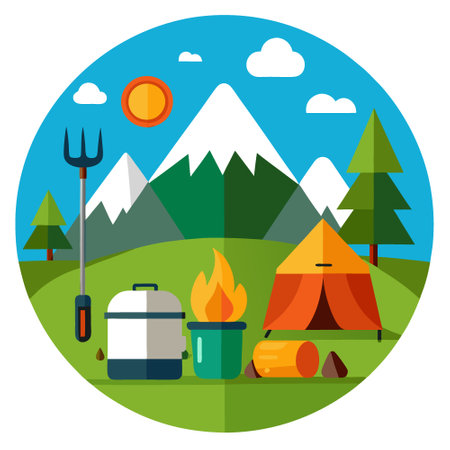1. Understanding Natural Disasters Common in India
Indias diverse geography and climate make it prone to a variety of natural disasters, which every camper should be aware of before heading out for an adventure. The Indian subcontinent regularly experiences monsoons that bring heavy rainfall, often resulting in floods across states like Assam, Bihar, and Kerala. Cyclones frequently impact the eastern coastlines, particularly Odisha and West Bengal, causing widespread damage. In northern regions, especially along the Himalayan belt, earthquakes are not uncommon and can lead to dangerous landslides. Additionally, heatwaves sweep across central and western India during peak summer months, posing serious health risks. Understanding these local threats is crucial for anyone planning a camping trip in India. Whether you are setting up your tent near the Western Ghats or embarking on a car-camping journey through Rajasthan, being equipped with knowledge about these hazards ensures better safety decisions. Always check regional weather updates and consult local authorities or experienced travelers (yatri) to get real-time advice about current conditions. Awareness of these risks is the first step in making your Indian camping experience both memorable and secure.
2. Essential Camping Gear for Disaster Preparedness
When camping in India—especially during monsoon, cyclones, or unexpected weather events—it’s critical to pack gear that can withstand local challenges and keep you safe. Here’s a breakdown of must-have equipment tailored for Indian conditions:
Gear |
Purpose & Local Insights |
|---|---|
All-Weather Tent (Monsoon-Proof) |
Choose tents with high water resistance (minimum 3000mm rating), strong wind stability, and double-layered design. In India, sudden downpours or dust storms are common—ensure your tent has proper ventilation to reduce humidity inside. |
Mosquito Net |
Essential across most Indian terrains—mosquitoes carry diseases like malaria and dengue. Opt for fine mesh nets that can be easily draped over sleeping areas or hung inside tents. |
Waterproof Bags & Dry Sacks |
Protects valuables and dry clothes from heavy rain or accidental submersion, especially during river crossings or flash floods. Use multiple sizes to organize electronics, food, and documents separately. |
Solar-Powered Lanterns & Torches |
Frequent power cuts occur during storms in remote regions. Solar lanterns are a sustainable option—charge during the day, use at night without worrying about batteries running out. |
Portable Water Purifier or Filter Bottle |
Access to clean water is unpredictable during disasters. Carry a filter bottle or portable purifier (like LifeStraw or ceramic filters) to safely drink from rivers, lakes, or taps wherever you camp in India. |
Basic First-Aid Kit (With Local Additions) |
Packed with antiseptics, bandages, anti-allergy tablets, painkillers, and oral rehydration salts—a must for treating minor injuries and dehydration in humid Indian climates. Add insect repellent and burn ointment specific to local risks. |
Packing Tips for Indian Conditions
- Layer Up: Weather swings between hot days and cool nights—even in summer months like May-June.
- Quick-Dry Fabrics: Choose clothing that dries fast after rain showers or river crossings.
- Pepper Spray/Whistle: For personal safety against wild animals (or rare human threats) in remote campsites.
- Cow Dung Cakes/Incense Sticks: Traditional methods used by locals to repel insects around campsites—consider carrying a few if camping near villages.
Being well-equipped is your first line of defense when camping amidst natural disasters in India. The right gear not only keeps you safe but also lets you enjoy the rugged beauty of India’s outdoors with peace of mind.

3. Local Insights: Indian Camping Know-How During Emergencies
Camping during natural disasters in India demands both resourcefulness and an understanding of local wisdom. Indian campers and rural communities have developed survival strategies blending traditional knowledge with modern solutions, a style often called “Jugaad”—the art of ingenious improvisation. Here’s how you can tap into these insights when disaster strikes on your camping journey.
Using Locally Available Materials
Indian campers rely heavily on what’s immediately accessible in nature or nearby villages. For shelter, robust bamboo poles serve as excellent supports for temporary structures, while locally sourced tarpaulins (often found at roadside markets) provide quick waterproofing against monsoon rains. Palm leaves, banana stems, and even gunny sacks are frequently used to reinforce makeshift roofs and walls, keeping interiors dry and insulated.
Water Collection & Purification
During emergencies, safe drinking water is crucial. Many locals use a combination of cloth filtration and boiling over open fires—a method that’s stood the test of time. Where possible, campers gather rainwater using clean tarps stretched between trees, collecting runoff in large utensils or buckets. In some regions, adding a pinch of alum (fitkari) helps sediments settle quickly before boiling.
The Spirit of Jugaad: Quick Fixes & Adaptations
Indians are known for their ability to adapt rapidly—turning ordinary items into lifesaving tools. Broken tent poles can be replaced with sturdy branches or bamboo; plastic bottles become emergency lanterns by inserting candles or LED torches inside them; old newspapers serve as both insulation and fire-starting material. When mobile signals drop during storms or landslides, locals often climb higher ground or use metal utensils to amplify weak signals—a classic Jugaad hack.
Community Networks & Shared Resources
In India, community spirit is a lifeline during crises. Campers are encouraged to connect with local villagers who often possess invaluable knowledge about flood-prone zones, animal movement patterns, and safe evacuation routes. Sharing resources—like food grains, portable stoves (chulhas), or even shelter space—is common practice. Participating in this mutual aid not only increases safety but also fosters bonds of trust essential for surviving adversity in the wild.
By blending age-old techniques with inventive solutions and relying on the power of community, campers in India are uniquely equipped to handle natural disasters with resilience and adaptability.
4. Safe Camp Setup: Choosing the Ideal Spot
When camping in India, especially during times when natural disasters like floods or cyclones are possible, selecting the right spot for your camp is crucial for safety and comfort. India’s diverse geography means that what works in the Western Ghats might not be ideal in Assam or Rajasthan. Here are some essential tips tailored for Indian contexts:
Tips for Selecting Safe Camping Spots
| Situation | What to Avoid | Recommended Action |
|---|---|---|
| Monsoon Season (June-September) | Setting up near riverbanks, nallahs, or low-lying fields prone to sudden flooding | Choose elevated ground away from water bodies; check for signs of previous flooding like debris lines or muddy patches |
| Flood-prone Areas (Assam, Bihar, Kerala, etc.) | Campsites at the base of hills or valleys where water can accumulate quickly | Select higher terrain with natural drainage; consider proximity to main roads for quick evacuation if needed |
| Mountain Regions (Himachal Pradesh, Uttarakhand) | Camping directly under cliffs or landslide-prone slopes | Look for flat areas away from steep inclines and rockfall zones; ensure there is a clear path to exit in case of emergency |
| Coastal Areas (Tamil Nadu, Odisha) | Pitches close to the beach during cyclone alerts or storm surges | Stay further inland, preferably behind natural windbreaks like groves of trees or sand dunes |
Respecting Local Communities and Forest Boundaries
In India, many camping areas are close to villages or forest reserves. Always seek permission from local panchayats or forest officials before setting up your camp. Not only is this respectful, but it also ensures your safety as locals often have valuable knowledge about weather patterns and wildlife movements. Avoid restricted forest zones and sacred groves—these may be protected by law or tradition. If unsure, ask around at the nearest dhaba or chai stall; locals are usually helpful and will guide you to safer locations.
Quick Checklist Before Setting Up Camp:
- Is the ground above recent flood marks?
- Are there any visible animal tracks or signs of wild elephants (especially in South India)?
- How far is the nearest shelter or road?
- Have you informed someone locally about your presence?
- Is your campsite out of direct wind channels during cyclone warnings?
By following these guidelines rooted in Indian realities, you can make your camping experience safer and more harmonious with both nature and local communities.
5. Communication and Emergency Contacts in India
Staying Connected: Local Solutions for Reliable Communication
When camping in India during natural disasters, maintaining a dependable means of communication can be lifesaving. Indian terrain and infrastructure are diverse—network coverage varies greatly from the Himalayan north to the coastal south. The best first step is to obtain a local SIM card (Airtel, Jio, BSNL are widely available) upon arrival. Local SIMs offer better connectivity and affordable data packs. In remote or forested areas, network boosters can be essential; portable signal amplifiers are available at major electronics markets in cities like Delhi or Bengaluru. Always test your connectivity before venturing deep into rural regions.
Essential Helplines Every Camper Should Know
India has robust emergency response mechanisms, but knowing the right numbers is crucial:
- National Disaster Response Force (NDRF): 011-24363260 / 1078 (toll-free)
- Police: 100
- Fire Brigade: 101
- Ambulance: 102 or 108 (in most states)
- Panchayat Office: Numbers vary by village; inquire locally upon arrival for the nearest panchayat contact.
Save these contacts on your phone and keep a written copy in your gear in case of device failure.
Navigating Regional SOS Procedures
Indias disaster protocols may differ between states and even villages. In flood-prone Assam or cyclone-hit Odisha, local authorities issue alerts via WhatsApp groups, FM radio, and loudspeakers. Ask locals about community sirens or signal codes—sometimes three long bell rings or a specific horn pattern indicate evacuation orders. If you’re in tribal or mountain regions, check with the local panchayat for their unique SOS practices. Always inform someone local of your campsite location and expected return time.
Packing Pro-Tip: Communication Gear Checklist
- Unlocked smartphone with dual-SIM capability
- Power bank (10,000mAh+ recommended)
- Portable network booster or Wi-Fi dongle
- Laminated emergency contacts list
Your ability to reach help quickly can make all the difference when nature throws a curveball—equip yourself with the right tools, know the key numbers, and always stay tuned to local advice for a safe Indian camping adventure.
6. Coping with Food, Water, and Hygiene During Disasters
Indian-Style Solutions for Emergency Nutrition
When camping in India during natural disasters, prioritizing local solutions for food is both practical and comforting. Carry ready-to-eat Indian foods like Theplas (spiced flatbreads from Gujarat), Parle-G biscuits (a national favorite), and poha (flattened rice) which can be quickly rehydrated with minimal water. These items are lightweight, have a long shelf life, and suit the Indian palate during stressful times. Avoid foods that require elaborate preparation or refrigeration, as power outages and fuel shortages are common during floods or cyclones.
Ensuring Safe Drinking Water
Access to clean water can become a serious challenge when rivers flood or waterlines break. Equip yourself with portable Indian water purifiers—many brands offer compact filters or chlorine tablets designed for local conditions. Boiling water remains a reliable option if you have access to fuel and safe cookware. Always carry extra bottles of mineral water, but also consider traditional techniques like using Moringa seeds (drumstick tree) to settle sediments if you must rely on natural sources temporarily.
Sustainable Hygiene Practices in the Indian Climate
Maintaining hygiene is crucial to prevent illness during disaster camping. Opt for biodegradable wet wipes and soaps; several Indian brands now offer eco-friendly options tailored for the country’s hot and humid climate. Bring reusable cloth towels instead of paper alternatives to reduce waste. For toilet needs, carry a small trowel for digging cat holes away from campsites and water sources—this method is both practical and respectful of the environment. Consider carrying a small bottle of neem oil or traditional herbal sanitizers for added protection against germs.
Packing Tips for Disaster-Ready Campers
Build your kit with local essentials: pack extra Theplas and poha in airtight containers, keep Parle-G packets handy for quick energy, store multiple sachets of oral rehydration salts (ORS), and always include a robust water filter. Choose hygiene products based on Indian weather—antibacterial powders work well during monsoon humidity, while coconut oil can help prevent skin dryness in winter evacuations.
Embrace Local Wisdom
The best way to cope during disasters is to prepare like a local: use foods that don’t spoil easily in Indian heat, practice traditional water purification methods, and follow sustainable hygiene routines that respect both health and nature.
7. After the Disaster: Respect for Nature and Local Communities
Once the immediate danger of a natural disaster has passed, your responsibility as a camper in India does not end. In fact, this is when your actions can make a lasting difference to both the environment and the local communities. Here are some essential guidelines to follow as you wrap up your camping experience:
Leave No Trace – Swachh Bharat Spirit
Adopt the “Leave No Trace” principle, which aligns perfectly with India’s Swachh Bharat (Clean India) mission. Carefully clean up your campsite, making sure to collect all waste—biodegradable and non-biodegradable alike. Dispose of garbage in designated areas or carry it back with you if no proper disposal facilities exist. Do not leave behind plastic bottles, food wrappers, or other litter that can harm local wildlife and pollute water sources.
Support Affected Locals
If the disaster has impacted nearby villages or towns, consider offering help to the affected locals. This could mean donating supplies, volunteering for clean-up efforts, or simply buying local products to support their recovery. Remember that many Indian communities are tightly knit and value gestures of solidarity—your willingness to help will be appreciated and remembered.
Respect Sacred Sites and Traditions
India is dotted with sacred groves, rivers, temples, and shrines—many of which may be close to popular camping spots. After a disaster, these sites may become even more significant for local rituals or community gatherings. Always ask before entering such places, avoid causing disturbance during religious ceremonies, and never remove offerings or artifacts. Respect for these traditions strengthens trust between travelers and host communities.
Contribute to Local Recovery Efforts
If you have resources or skills that can aid recovery—such as first aid training, technical know-how, or simply extra hands for rebuilding—you can coordinate with local authorities or NGOs working on the ground. Even small contributions, like planting native saplings to replace lost vegetation or sharing emergency supplies with families in need, embody the spirit of responsible camping in India.
Your journey through India’s wilderness should leave positive footprints: clean campsites, empowered communities, and deepened cultural understanding. By acting responsibly after a disaster, you honor both Mother Nature and the diverse peoples who call her home.


